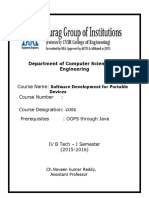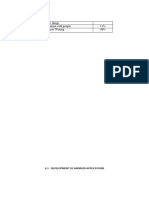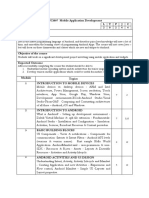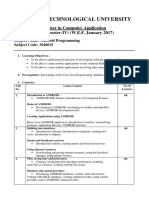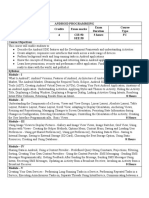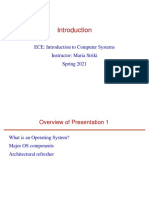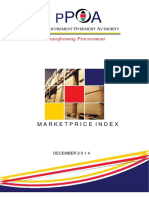Diploma in Computer Engineering
Mobile Computing Credit: 03
Subject Title:
Subject Code: COPE301/302 Semester: --
Lecture Hrs. / week: 03 Hrs. Tutorials Hrs. / week: 00 Hrs.
Total Hrs. / semester: 45 Hrs.
End semester 60 Marks. Progressive 40 Marks.
Assessment Theory: Assessment Theory:
RATIONALE/AIM: RATIONALE/AIM: The Mobile Computing Lab studies design principles and evaluation
methodologies for understanding and building systems support mechanisms for mobile computing systems
including mobile ad hoc and sensor networks for achieving the goal of anytime, anywhere computing in
wireless mobile environments. The primary research focuses of the Mobile Computing Lab are in mobility
management, data and service management, security and dependability aspects in mobile computing
environments.
COURSE OUTCOME: After successful completion of the course, students will be able to:
1. Provide a solid foundation and skills for programming to create applications for Mobile Devices
2. Install, configure and use Android development environment.
3. To Learn about Basic Mobile Application Development tools
4. To learn How to create interactive applications in android with multiple activities
5. Create Mobile Application Portfolio using Android and IOs.
SUBJECT CONTENTS
UNIT TOPICS / EXPERIMENTS
1. UNIT 1:
A brief history of Mobile, Types of mobile phone generations, The Mobile Ecosystem, Types of
Mobile Applications, Mobile Information Architecture Android Versions, Features of Android,
Android Architecture,Installing Android SDK Tools, Configuring Android in Eclipse IDE, Android
Development Tools (ADT), Creating Android Virtual Devices (AVD)
2. UNIT 2:
Creating first android application, Anatomy of android application, Deploying Android app on USB
connected Android device, Android application components, Activity life cycle, Understanding
activities,Exploring Intent objects, Intent Types, Linking activities using intents.
3. UNIT 3:
Fragments life cycle, Interaction between fragments, Understanding the components of a screen,
(Layouts), Adapting to display orientation, Action Bar, Views(UI Widgets)-Button, Toast,
ToggleButton,CheckBox, RadioButton, Spinner, WebView, EditText, DatePicker, TimePicker,
ListView, Progress-Bar, Analog and Digital clock, Handling UI events, List fragment, Dialog
fragment.
4. UNIT 4:
Menus-Option, Context, Popup, Images-ImageView, ImageSwitcher, AlertDialog, Alarm
manager,SMS, E-mail, Media Player, Using camera, recording video, Handling Telephony Manager.
5. UNIT 5:
Storing the data persistently-Data Storage Options: preferences, Internal Storage, External
Storage,Content Provider , The SQLite database, Connecting with SQLite database and operations-
Insert, Delete,Update, Fetch, Publishing android applications, Deploying APK files.
SUGGESTED LEARNING RESOURCES:
Reference Books:
1. Wei-Meng Lee, Beginning Android 4 Application Development, Wiley Publishing, Inc.
2. Pradeep Kothari, “Android Application Development Black Book”, DreamTech Press
3. James C.Sheusi, “Android Application Development for Java Programmers”, Cengage Learning
4. Mark L Murphy, “Beginning Android”, Wiley India Pvt Ltd
5. Sayed Y Hashimi and Satya Komatineni(2009), “Pro Android”, Wiley India Pvt Ltd
6. Reto Meier, Professional Android 4 Application Development, Wiley India Pvt Ltd
State Board of Technical Education, Sikkim (Revision No: SBTE/COM/S/7500/I (JUNE 2022) Page 50
Syllabus approved by: SBTE, Govt. of Sikkim

